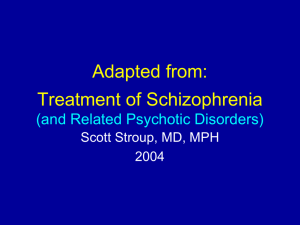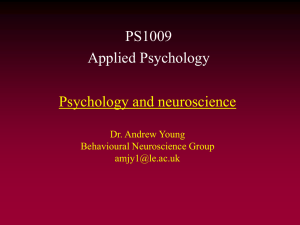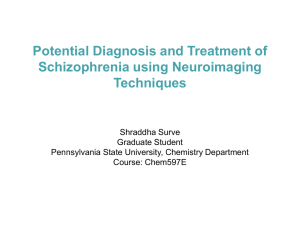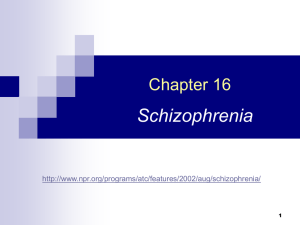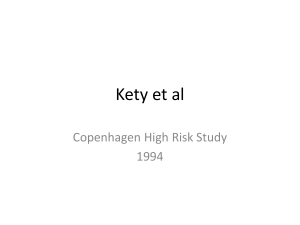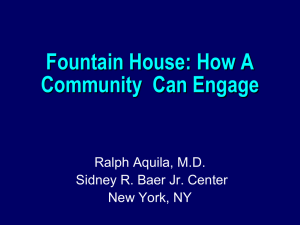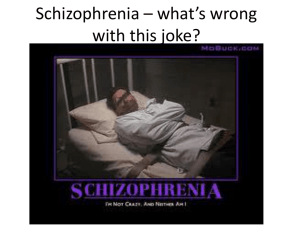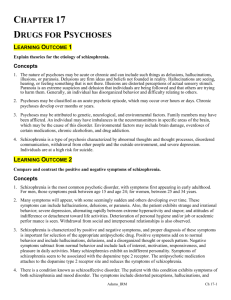SZ A2 mock feedback
advertisement
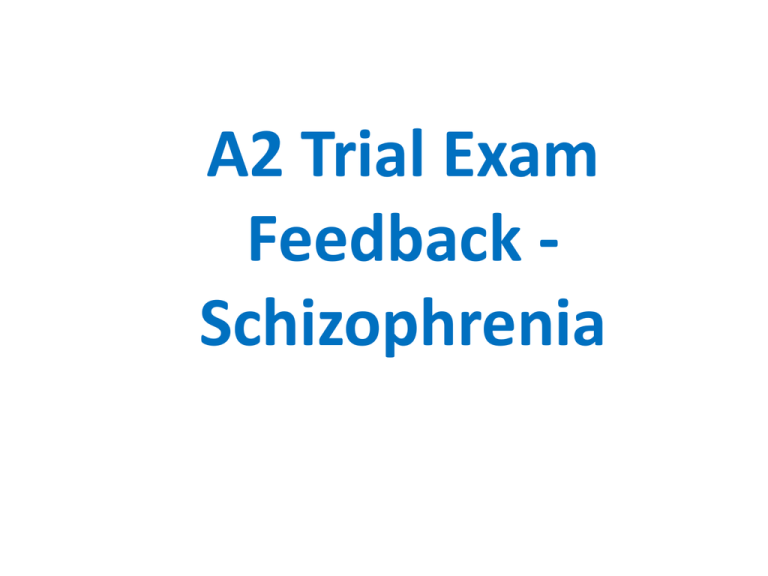
A2 Trial Exam Feedback Schizophrenia Outline and evaluate one biological therapy for schizophrenia (4+8) AO1 • The most likely therapy is the use of antipsychotic drugs. 1. Typical e.g. phenothiazines like chlorpromazine – block D2 receptors (dopamine antagonist). 2. Atypical e.g. clozapine - may block serotonin receptors as well. • Other biological therapies such as ECT can also gain credit A01: Antipsychotic Drugs • Conventional typical antipsychotic drugs (e.g. phenothiazines, such as chlorpromazine). • These drugs work by blocking the receptors in the synapses that absorb dopamine. • Effectively they reduce the action of dopamine, and this is done within 48 hours. • In other words they are dopamine antagonists. • They bind specifically to D2 receptors but do not stimulate them therefore blocking their action. • The effectiveness of these drugs in reducing hallucinations and delusions led to the dopamine hypothesis of schizophrenia (i.e. the biochemical explanation of schizophrenia studied earlier in the course). A01: Antipsychotic drugs • Newer atypical antipsychotic drugs (e.g. clozapine). • These also act on the dopamine system, but are thought to block serotonin receptors in the brain too. A01 Marks • 4 – knowledge and understanding are accurate and well-detailed • 3 – knowledge and understanding are generally accurate and reasonable detailed • 2 – basic/superficial knowledge and understanding • 1 – rudimentary – knowledge and understanding brief/muddled • 0 – no creditworthy material AO2 • Evaluation is likely to relate to effectiveness and appropriateness. • Atypicals most effective i.e. reduce + and – symptoms • Conventional drugs side effects – tardive dyskinesia • Atypical side effects. • 30% do not respond to treatment • Effective e.g. supporting research evidence • Palliative therefore relapse occurs AO2 marks • 8-7 – effective: Sound analysis and understanding. Well focussed and coherent elaboration. Consistent use of psychological terminology. • 6-5 – Reasonable: Reasonable analysis and understanding. Generally focussed & reasonable elaboration. Appropriate use of terminology. • 4-3 - Basic: basic, superficial understanding. Sometimes focussed, some elaboration. Lacks clarity. Limited use of terminology • 2-1 – Rudimentary: very limited understanding, weak muddled, incomplete. • 0 – no creditworthy material Mark scheme • “Treatments other than drug therapy will need to be read carefully to assess the effectiveness of evaluation. Students who cover ECT as AO1 should make it clear that this treatment was used historically but has not been widely used for schizophrenia or deemed appropriate in recent years. However, its more recent use in conjunction with antipsychotics for drug resistant patients could provide effective evaluation.” • Answers focussing on these treatments are likely to be basic. Chief examiner’s feedback • “The best route to good AO1 and AO2 marks was to focus on…currently used (treatments)…..and to include reference to outcome studies” • I.e. studies which show that they reduce symptoms of SZ/relapse rates Using research as AO2 • “Research shows that…..” • “Davis et al analysed 29 studies….” • Neither of these are going to be effective evaluation as the reader does not know they are evaluation • Introduce research as evaluation • “Research supports that drug therapy is effective. E.g. Davis found….” • Use P.E.E.L structure we have practiced! How would you improve these answers? • “Another issue is that drugs are palliative and not a curative treatment. These reduce symptoms but as soon as the patient is off the drugs it will reappear. Therefore drug therapy is limited” • “A strength of the therapy is that it provides immediate relief which is important if the patient is a danger to themselves or others. Therefore it is fast-acting in comparison to psychological treatments which take weeks” Q: How would you improve these answers? A: Relate specifically to schizophrenia! – to achieve reasonable/effective marks “Another issue is that drug therapy such as antipsychotics are palliative and not a curative treatment. These reduce symptoms of schizophrenia but as soon as the patient is off the drugs schizophrenia will reappear. Therefore drug therapy is limited” “A strength of antipsychotics is that they provide immediate relief which is important if the patient is a danger to themselves or others e.g. due to delusions and hallucinations. Therefore it is fast-acting (e.g. 48 hours) in comparison to psychological treatments such as family therapy which take weeks” Outline and evaluate one psychological therapy for schizophrenia (4+8) AO1 • A variety of options available e.g. CBT-related, familybased interventions and social interventions. • Behavioural approaches used to ‘manage’ schizophrenia e.g. token economy is creditworthy. • Psychodynamic therapies are creditworthy but must make clear these are no longer used/suitable for most people. • NOT biological e.g. ECT! A01 Marks • 4 – knowledge and understanding are accurate and well-detailed • 3 – knowledge and understanding are generally accurate and reasonable detailed • 2 – basic/superficial knowledge and understanding • 1 – rudimentary – knowledge and understanding brief/muddled • 0 – no creditworthy material Chief examiner’s feedback • “Better answers shaped descriptions of CBT specifically to the symptoms of schizophrenia (e.g. logical disputing to challenge delusional beliefs) but weaker answers provided generic descriptions of AS quality with little attempt to apply these to the unique symptoms/features of schizophrenia and were awarded basic marks. Descriptions of family therapy often lacked detail.” AO2 marks • 8-7 – effective: Sound analysis and understanding. Well focussed and coherent elaboration. Consistent use of psychological terminology. • 6-5 – Reasonable: Reasonable analysis and understanding. Generally focussed & reasonable elaboration. Appropriate use of terminology. • 4-3 - Basic: basic, superficial understanding. Sometimes focussed, some elaboration. Lacks clarity. Limited use of terminology • 2-1 – Rudimentary: very limited understanding, weak muddled, incomplete. • 0 – no creditworthy material AO2 • Likely to cover effectiveness and appropriateness • E.g. studies showing that CBT/family therapy etc. reduce symptoms of schizophrenia/prevent relapse • Effective for some symptoms not others e.g. CBT does not address negative symptoms • Lengthy in comparison to biological therapy • Family therapy suitable for 65% who return to live with family, therefore not suitable for 35% Chief examiner’s feedback • “In better answers, evaluation was clearly organised around three main areas, appropriateness, effectiveness and ethical issues. “ • “Weaker students continue to show little understanding that treatment is free at the point of delivery in the UK” • - so it must be in terms of cost to the government rather than patient!


